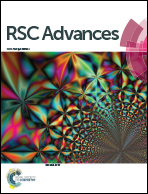Bio-inspired HDPE-based dry adhesives and their layer-by-layer catechol modification on the surface for use in humid environments†
Abstract
We applied thermal imprinting to fabricate gecko-foot-like nanostructures on HDPE films and modified those surfaces via dopamine and catechol to enhance their adhesion to wetted substrates. The dry adhesive was inspired by gecko feet, where multi-dimensional micro/nano structures on the surfaces can generate enough van der Waals force to hold a gecko's weight when it walks and presses on the surface to increase contact area. The other concept of catechol modification came from adhesion on a variety of surfaces by mussels, which are known to secrete a sticky liquid containing dopamine-related poly(aminoacid) to enhance their universal adhesion properties in air, even in a humid or aqueous circumstances. Experimentally, polycarbonate sheets with nanoholes were used as templates to imprint general HDPE film surfaces to generate 400 nm diameter nanopillars. The demolding process was improved by using solvent replacement techniques to fabricate a practical and large-area gecko tape. The surface completeness was enhanced to 95%, and the tape with 400 nm diameter nanopillars showed 3170 nN adhesion force and was able to suspend 10.5 N cm−2. In order to apply the adhesive in a humid environment, we introduced the catecholic functional group on the nanopillars using a two-step method to modify the surfaces with catechol groups. The surfaces were first modified with an acidic dopamine aqueous solution, and then they were modified with alkaline catechol aqueous solution. An additional microcontact printing technique was used to modify nanopillared domains with 1-dodycanethiol chains, showing an improvement of adhesion interaction in water due to the hybrid contribution of both polar and nonpolar interactions with the substrate.


 Please wait while we load your content...
Please wait while we load your content...